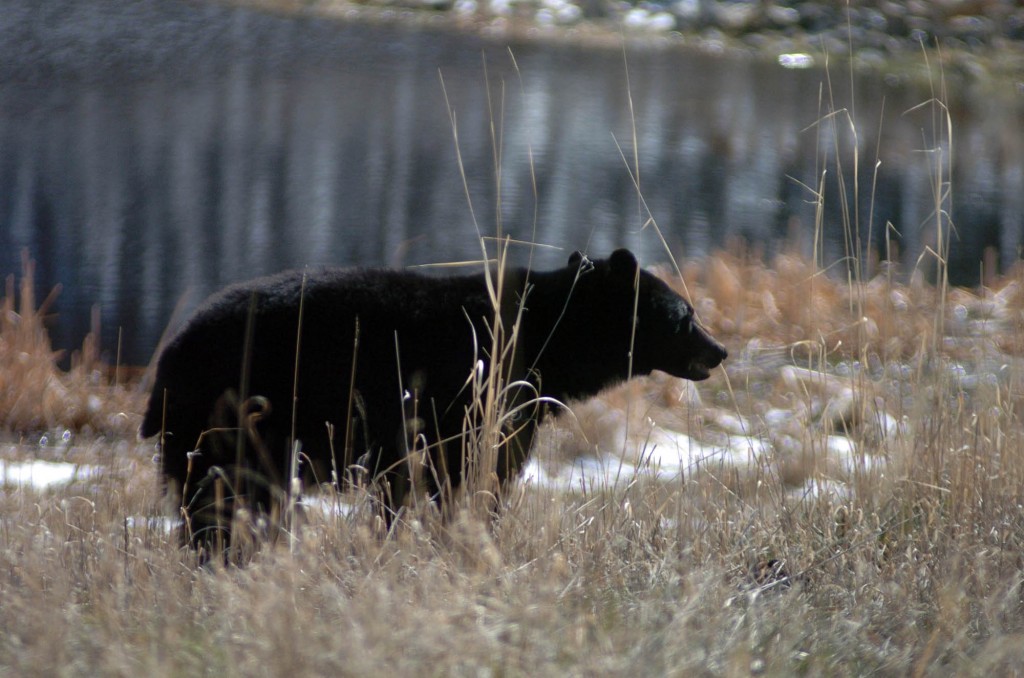A black bear prowls the banks of a pond near Roosevelt Lodge in June 2010. (Ruffin Prevost/Yellowstone Gate)
CODY — A cable TV news crew taping a July 2011 segment on bear safety in Yellowstone National Park got a little something extra in the bargain: a close encounter with a bear.
“That was what we refer to as an incident within an incident,” park spokesman Dan Hottle, joking that he worried some might think the encounter was staged.
Hottle had taken the crew from CNN to Joffe Lake — a five-minute drive from park headquarters in Mammoth Hot Springs — where they were interviewing Yellowstone bear biologist Kerry Gunther.
The park’s public affairs office has received hundreds of media inquiries since the fatal mauling earlier in the week of a hiker who apparently surprised a mother grizzly that was foraging with two six-month-old cubs.
Brian Matayoshi, 57, of Torrance, Calif., was killed while hiking with his wife, Marylyn, on the Wapiti Lake trail. It was the first fatal bear attack in Yellowstone since 1986.
So park visitors were still on high alert when someone spotted a black bear at Joffe Lake, a popular fishing spot for brook trout and a convenient backdrop for Gunther to explain how to behave during a bear encounter.
“Someone shouted, ‘Bear! Bear!'” Hottle said, recalling the incident.
Hottle wanted to make sure hiker Erin Prophet saw the nearby black bear as it ambled toward the 2.5-acre pond.
“Does the hiker know?” Hottle shouted back, as a videocamera captured the unfolding drama.
As Prophet backed away from the bear, she found herself wading into the pond, wondering whether to swim for the far shore.
Dave Beecham, in a nearby kayak with his young son and his father-in-law, paddled over to help Prophet swim away from the bear.
Although the bear never charged and did not appear to be directly threatening her, Prophet told the camera crew that she was scared, and glad for the help.
“I was pretty afraid,” she said.
“When the guys in the kayak offered to pull me across, that seemed like a better plan because the bear seemed like it wanted to be down there by the edge,” Prophet said.
Beecham was visiting the park from Oregon, and later told KGW news of Portland that he felt compelled to help, but he was also “afraid the grizzly bear was going to come after us.”
Hottle said the black bear, initially misidentified as a juvenile grizzly, was not interested in Prophet, and was just trying to get to the water.
Hottle said the incident would have gone unheralded were it not for the presence of news cameras in the wake of Wednesday’s mauling.
He said Gunther had hoped to use the national platform of a CNN segment to offer common-sense advice on staying safe in bear country, but the resulting segment instead focused mostly on the kayak “rescue.” Local news outlets in Beecham’s home state of Oregon picked up the story and also played up the rescue angle.
Park officials have continued to stress how rare grizzly attacks are, and say that Yellowstone averages only approximately one bear-related injury each year. Gunther said during a press conference last week that Wednesday’s fatal mauling was a “1-in-3-million” chance encounter.
While most visitors to the area seemed unlikely to change their plans based on news of the fatal attack, it was a hot topic in tourist towns near the park.
Sales of bear spray were up sharply at a camping supply store in Cody, near the park’s East Entrance.
“People are definitely talking about it when they come in,” said Amber Bryant of Sunlight Sports. “Some people have actually changed their minds and decided not to go hiking at all.”
Bryant said that most customers, though, are heading to the backcountry as planned.
“The bears have been there long before people,” she said.
Contact Ruffin Prevost at 307-213-9818 or ruffin@yellowstonegate.com.

